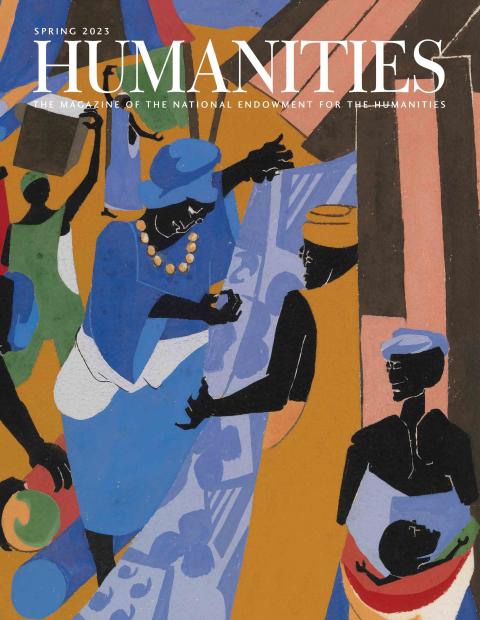This issue is about affinities—forged, explored, and, sometimes, in need of repair.
The American painter Jacob Lawrence visited Nigeria in the 1960s and immersed himself in the country’s postcolonial creative ferment. He discovered an affinity with artists and writers in a group called the Mbari Club, publisher of the journal Black Orpheus. The story is told in an intriguing NEH-supported exhibition, which opened at the Chrysler Museum of Art in Norfolk, Virginia, and is now on view at the New Orleans Museum of Art. Writer Kristina Kay Robinson takes us there.
NEH Chair Shelly C. Lowe (Navajo) interviews Henrietta Mann (Cheyenne), an educator who, as this issue went to press, was awarded the National Humanities Medal by President Joe Biden. (Profiles of all the medalists will run in the summer issue). A child of two great grandmothers who survived the massacres at Sand Creek and Washita River, Mann played a formative role in the field of Native American studies. She became a much sought-after speaker and college president. Now in her eighties, Mann talks about the ongoing search for a way of life that puts us in community with nature and with each other.
Mother Cabrini was born in Italy, became a nun, and came to the United States in 1889, writes Nick Ripatrazone. The short-statured and courageous Cabrini built schools, hospitals, and even churches, reuniting immigrants with the spiritual tradition they had left behind—and thus became the first American to be named a saint by the Catholic Church.
John James Audubon is in the news as bird-lovers question their connection to this nineteenth-century artist and biographer of birds. Christoph Irmscher of Indiana University, Bloomington, sketches an answer by focusing on Audubon’s art and what he calls the “radical parts of his legacy.”
Martha Gellhorn was known for her writing, her looks, and her marriage to Ernest Hemingway—and not always in that order. Alyson Foster profiles the novelist and gutsy war correspondent who sneaked into France and toured China. It’s a writer’s life, above all, with occasional triumphs and many a prosaic lull, though the prose tends to be excellent.
“Maḏayin” is an NEH-supported show of bark paintings that the Wall Street Journal said was “the most important exhibition of Aboriginal Australian art mounted in the western hemisphere in over 30 years.” Now at the American University Museum in Washington, D.C., Angelica Aboulhosn went over and took a look.
And there is more, including a profile of NEH’s senior deputy chair, Anthony Mitchell. The former head of human resources at NEH, Mitchell is supremely competent and something of an unofficial mayor at NEH—a natural leader. Yet he was taken aback, he says, when Chair Lowe asked him to become her number two.

